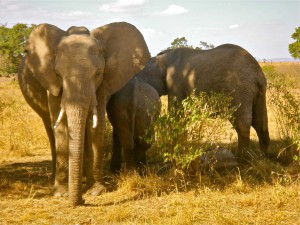 When it comes to combating cancer does size matter? If every cell in the body has the propensity to become cancerous, it should naturally follow that larger animals that pack greater number of body cells and that those whose cells undergo greater number of cell divisions are more likely to develop cancer. By the same logic, organisms with longer lifespans must also have a greater chance of accumulating mutations leading to cancer. Surprisingly, the risk of developing cancer is only 5% in elephants and 18% in whales whereas it is as high as 30% in humans and rodents. The apparent lack of correlation between body mass, longevity and cancer- known as Peto’s paradox- has flummoxed scientists for several decades.1
When it comes to combating cancer does size matter? If every cell in the body has the propensity to become cancerous, it should naturally follow that larger animals that pack greater number of body cells and that those whose cells undergo greater number of cell divisions are more likely to develop cancer. By the same logic, organisms with longer lifespans must also have a greater chance of accumulating mutations leading to cancer. Surprisingly, the risk of developing cancer is only 5% in elephants and 18% in whales whereas it is as high as 30% in humans and rodents. The apparent lack of correlation between body mass, longevity and cancer- known as Peto’s paradox- has flummoxed scientists for several decades.1
A recent study published in Journal of the American Medical Association by Abegglen and colleagues has unlocked the secret weapon held by the pachyderms in fighting cancer2. While the weapon itself might not be new to cancer biologists, the stash carried by these marvelous animals is the highest recorded for any living species so far. To understand this weapon let’s revisit the coping mechanisms developed by cells to prevent cancer. When mammalian cells are exposed to cancer inducing treatments, such as UV radiation for example, a gene encoding TP53, kicks into gear making copies of the tumor suppressing protein of the same name. TP53 acts as a tumor suppressor, which means that it regulates cell division by keeping cells from growing and dividing too fast or in an uncontrolled way. It does so by either repairing any damage to the cells caused by the UV exposure or by killing off the cell by a self-destructing mechanism known as apoptosis which is akin to committing suicide.
Many mammals, including humans carry only two copies of this important gene; one copy or allele is inherited from each parent. If the TP53 gene is inactivated by mutations, the risk of developing cancer increases by several fold. A rare but lethal condition called Li-Fraumeni Syndrome marks patients who have only one working copy of TP53 with more than a 90 percent lifetime cancer risk from childhood into their adult years. In a quest to investigate the unexplained resistance to cancer by elephants, the scientists combed through the elephant genome and stumbled upon 40 copies of genes that code for TP53. One pair was ancestral in origin, whereas the remainder appear to have diverged from the ancestral copy and were archived within the genome over the course of evolution as retrogenes.
How do the extra copies of the TP53 gene keep cancer at bay? Do the extra copies help repair UV-damage to cells at a faster rate? To address this possibility, both human cells and elephant cells were dosed with radiation thereby damaging their DNA. Contrary to the researchers’ expectations, the elephant cells were not any more efficient at restoring damaged DNA than human cells. To their surprise, however, the elephant cells were killed at a faster rate after radiation exposure than were human cells. Moreover, they found that elephant cells exposed to radiation committed suicide at twice the rate of healthy human cells and more than five times the rate of cells from Li-Fraumeni patients. Thus extra copies of the TP53 gene enabled elephants to nip the problem in the bud by getting rid of potentially cancerous cells before they form tumors.
A parallel study conducted by Vincent Lynch and his co-workers corroborates these findings in African and Asian elephants3. Using luciferase reporter gene analysis, this team demonstrated that additional copies of TP53 greatly enhanced the sensitivity of elephant cells to DNA damaging signals and triggered apoptosis (cell suicide) in damaged cells at lower thresholds of genotoxicity. Although the data suggest that elephant TP53 retrogenes likely produce functional protein, it remains to be verified experimentally. What is clear so far is that these mighty animals have successfully outsmarted a deadly disease which opens new avenues in searching for therapeutics to treat cancer in humans.
References
- Caulin, Aleah F. and Maley, Carlo C. Peto’s Paradox: Evolution’s Prescription for Cancer Prevention. Trends Ecol Evol. 2011 Apr;26(4):175-82. doi: 10.1016
- Abegglen LM, Caulin AF, Chan A, et al. Potential Mechanisms for Cancer Resistance in Elephants and Comparative Cellular Response to DNA Damage in Humans. JAMA. 2015 Oct 8:1-11. doi: 10.1001/jama.2015.
- Sulak M, Fong L, Mika K, et al. TP53 copy number expansion correlates with the evolution of increased body size and an enhanced DNA damage response in elephants. bioRxiv doi: http://dx.doi.org/10.1101/028522
Radhika Ganeshan
Latest posts by Radhika Ganeshan (see all)
- T-Vector Cloning: Answers to Frequently Asked Questions - February 19, 2016
- Beating the Odds of Cancer: Not Just a Tall Tale - October 12, 2015
- Removing Cancer’s Cloak of Invisibility - April 20, 2015
